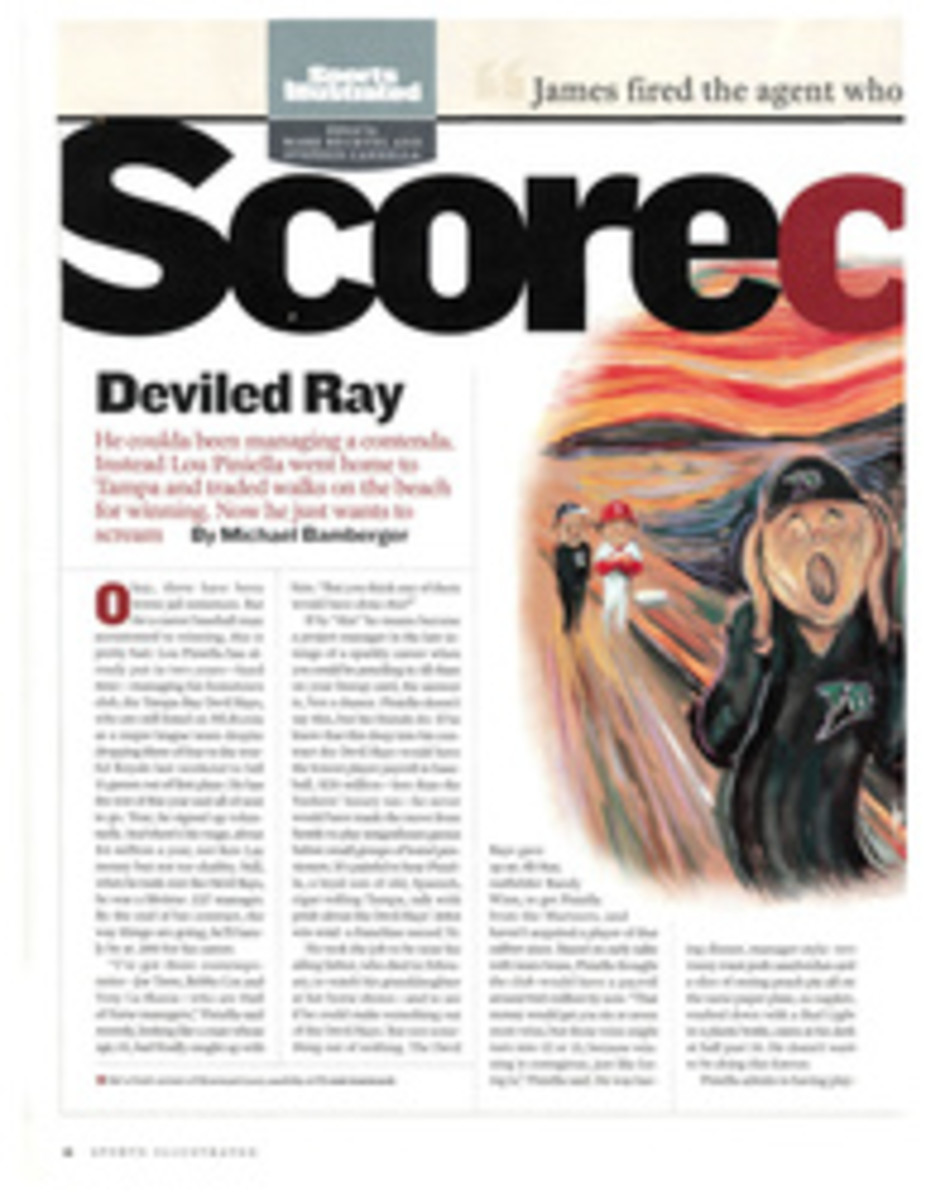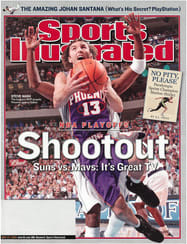
More Fun With The Suns
Contested shots will wound us. Uncontested shots will kill us. --Mavericks coach Avery Johnson, on a placard in the Dallas locker room
If Johnson's adage is true, then Dallas should have been fitted with a blue-and-white toe tag by the end of the third quarter of Sunday's Game 4 against the Suns. On play after play, Phoenix point guard Steve Nash steamed toward the basket while most of the Mavericks watched from outside the lane, mere feet away. Nash flipped in runners, spun in layups and swished pull-up jumpers as uncontested as a Vladimir Putin election en route to a game-high 48 points. It was a virtuoso postseason performance, the kind that gives fans goose bumps and defenders nightmares. To hear the Mavs tell it, however, they couldn't have been more pleased with Nash's production. "That was the idea," Dallas forward Josh Howard said afterward, nodding sagely. "We're a whole lot better off staying with our men than letting him pass them the ball."
As absurd as it sounds--We held him to 48!--Howard was right. After Nash finished with 27 points and 17 assists in Phoenix's 119-102 Game 3 win (anyone still want to argue that MVP vote?), Dallas rolled to a series-tying 119-109 victory two nights later by limiting the other Suns, inducing nine turnovers from Nash (versus only five assists) and smothering the previously indomitable Amaré Stoudemire inside (15 points). In the process Johnson employed the most entertaining defensive strategy in aeons--that is, if you consider allowing an All-Star to hit 20 of 28 shots, as Nash did, a defensive strategy.
It was just the latest twist in a Western Conference semifinal that has been intriguing and exhilarating. It's a shame that the games have often ended after midnight in the East because they've been the antithesis of stereotypical playoff basketball--the isolation plays, the NFL-caliber grappling, the backdowns so methodical that their perpetrators should beep like delivery trucks. Rather, at week's end the Suns and the Mavs had provided triple-digit scoring in every game; a one-man slam-dunk contest pitting the 6'10" Stoudemire against himself (six flushes in 13 baskets in Game 3); a pick-and-roll clinic courtesy of Nash; one scary injury (to Suns guard Joe Johnson, who suffered a displaced orbital fracture above his left eye after attempting a stuff and is likely out for the series); a host of unusual adjustments from the fiery Dallas coach (like putting the 6'7" Howard on the 6'3" Nash); and such a shortage of brutish play that, at one point, the Mavs went 21/2 quarters without shooting a free throw. As Avery Johnson put it, "It's just a great Western Conference shootout."
Most of the credit for this must go to Phoenix. The team's hyperkinetic offense, summed up on its locker room whiteboard ONLY SUNS RUN FOR 48:00, was averaging 114.5 points in the playoffs through Sunday, the most since the 1994 Golden State Warriors' 116.0. Even after the Mavs made baskets, Phoenix often fired a return volley within eight seconds--or about when a team like the Detroit Pistons would just be bringing the ball across half-court. During one sequence in the fourth quarter of Game 3, Nash drove and made a beautiful kickout to forward Shawn Marion for a three-pointer, Nash drove again and fired a lefty bullet pass to guard Jim Jackson for another three, Jackson tipped in a Stoudemire miss, Nash spun in a nifty lefty reverse layup, Nash hit an improbable lefthanded skyhook over 7-foot Dirk Nowitzki, and Marion stole the ball, tore down court and dunked it from somewhere near Waco. Elapsed time: 2:52. Point swing: 14. Highlights: four, minimum.
"They seem like they don't get tired," Avery Johnson said afterward. "Their starters all played 41 minutes or more, [and] they all looked like they could play some more." The Suns' Mike D'Antoni, the Coach of the Year, has a theory about that. "Guys like to play games like this," he says. "When they're getting 36, 40 points a game, it's"--and here he mimics a player rubbing his hands together gleefully--"'When we going to play again, Coach?'"
Phoenix has even made that most staid of plays, the pick-and-roll, sexy. Whereas the Utah Jazz rendition was considered boring if ruthlessly effective (John Stockton finds Karl Malone, who barrels to basket and gets fouled ... again), the Nash-to-Stoudemire version is far more unpredictable and explosive because it integrates all five players. Stoudemire sets the screen, usually at the elbow or on the wing, and rolls to the rim as the Suns' deadeye shooters spot up--and, for a delicious moment, as D'Antoni puts it, "there's nobody on anybody." The defense must make a snap decision. Double Stoudemire, and Nash will hit a jump shot or drive. Double Nash, and he'll find Stoudemire, often with a bounce pass, for a thunderous dunk. Help on Stoudemire by coming off the shooters, and leave yourself vulnerable to a three-pointer. Says Mavs point guard Jason Terry, who's been Nash's primary defender, "This guy is a mastermind at dissecting the defense. You can't play him to go left or go right, you have to play him straight up, and [you have to] stay down."
Part of the fun has been watching how the Mavericks respond to this pick-and-roll predicament. They had limited success in Game 2, which Dallas won 108--106 on a climactic Nowitzki jumper, but fell apart in Game 3 when, according to Dallas's stats, the Suns ran the pick-and-roll 40 times and scored 61 points off of it, nowhere near Johnson's goal of permitting just one point per possession. "We covered it three different ways," explained assistant coach Del Harris, frowning. "None really worked." So Game 4 brought the rope-a-dope strategy against Nash and the pack-the-paint approach to Stoudemire, who was held dunkless after being double- or triple-teamed on every roll. It didn't work perfectly, but as Harris noted while reading off of the index cards he keeps in his shirt pocket during the game, it was good enough: 14 points on 21 possessions in the first half and 44 points on 45 overall.
In years past, of course, the Mavs wouldn't have been concerned with limiting their opponent's scoring but rather focused on ratcheting up their own. Defense is at the core of Johnson's coaching approach. A Gregg Popovich protégé who had an itinerant 16-year career as a scrappy, vocal point guard, Johnson could hardly be more different than the man he replaced on March 19, the mad scientist of offense, Don Nelson. Whereas Nellie used to pull players if they didn't take an open shot, Johnson has benched his star, Nowitzki, for shabby post defense. Knowing that most NBA players would rather attend a potluck at David Stern's than D up, Johnson created an incentive system: Whoever played the best defense got the first play called for him the following game. "He makes you accountable," says Terry. "We have a defensive edit of game tape, then we'll watch offense, but the defense is always first." Adds swingman Michael Finley, "Avery's trying to make defense fun for us."
Johnson's other quest in the series has been no less difficult: getting consistent play from his center, Erick Dampier. In Games 2 and 4 Dampier played major minutes and logged double doubles; in the two losses he averaged 2.0 points and 4.5 rebounds. Predicting how he would play was like being on a game show: Behind door number 1 is a productive NBA big man; behind door number 2, a lethargic 7-footer so ineffective that Shaquille O'Neal, in critiquing his own performance last week, lamented, "I'm playing like Erick Dampier."
Johnson has tried a variety of strategies to prod Dampier. After Game 1 he joined with Nowitzki in challenging the center's manhood, saying, "No one can hide right now. You've got to really put up or shut up." After Game 3's letdown, he vowed to keep Dampier on the court even if he got in early foul trouble. And after Dampier's strong Game 4, Johnson appealed to him for more of the same. Dampier claims he has changed nothing. "I just try to play hard on both ends of the floor all the time," he said, not so convincingly.
In contrast to Dampier's fluctuating play was the sustained brilliance of Nash, whose legend seems to grow with each hair-whipping drive to the basket. Always popular, he seems to have become even more of a folk hero--the little guy made good--after edging O'Neal for the MVP. In Phoenix they showered him with cheers, and in Dallas, his home for six seasons, it was almost as if he'd never left. The arena was dotted with number 13 Suns jerseys; a throng of small boys chanted, We want Nash! during pregame warmups; and his signed Mavericks jersey was still available at the American Airlines Center fan shop (at the low, low price of $799).
In fact, it's hard to find anyone who doesn't like Nash, either for his entertaining style of play or his all-around dudeness. His teammates profess to love him: "He does as much coaching as the coaches," says backup center Steven Hunter. Canadians all but deify him: Forward Quentin Richardson calls him Wolverine, after the X-Men hero, because of his nationality, his furriness, his effect on the ladies and the way he "slices and dices the defense." And D'Antoni gushes, "It's impossible not to have a great relationship because he's exactly what a coach wants and needs and dreams of." Even his tendency to tuck his hair behind his ears has caught on; players in rec leagues as far away as New York City have been spotted licking their fingers and rearranging their locks a la Nash. Told of this phenomenon, Nash cracks up. "That's pretty stupid," he says. "I wish I didn't do it, to be honest. But in the game you'll do anything to win. If my hands are dry, I'll lick my fingers, no matter how stupid I look. And if my hair's in my face and my girlfriend won't let me cut it, I'll brush it out of my face, no matter how stupid I look doing that as well."
No matter which side of the hair divide you come down on, one thing seems clear: Nash & Co. are making the playoffs exciting again. And on Sunday one question remained: Can the Wolverine kill the Mavs, or will he merely wound them?
Johnson employed the MOST ENTERTAINING DEFENSIVE STRATEGY in aeons--that is, if you consider allowing Nash to hit 20 of 28 shots a defensive strategy.
"Guys like to play like this," says D'Antoni. "When they're getting 36, 40 points a game it's"-- he mimics a player rubbing his hands in glee--"'When we going TO PLAY AGAIN?'"
COLOR PHOTO
Photographs byJohn W. McDonough
VINTAGE NASH
The favorite Sun was sky high in Game 2, but Nowitzki (41) and Dallas got the better of their old mate.
COLOR PHOTO
Photographs byJohn W. McDonough
JUST GIVE A DAMP!
When the much-maligned Dampier came to play, the Mavericks prevailed.
COLOR PHOTO
Photographs byJohn W. McDonough
DROP ZONE
Until Dallas figured out how to slow the pick-and-roll, Stoudemire put on a dunking display.
COLOR PHOTO
Photographs byJohn W. McDonough
THE TAO OF STEVE
His hair-tucking habits may be mimicked from coast to coast, but Nash's more lasting influence has been as a playmaking stylist on the court.

